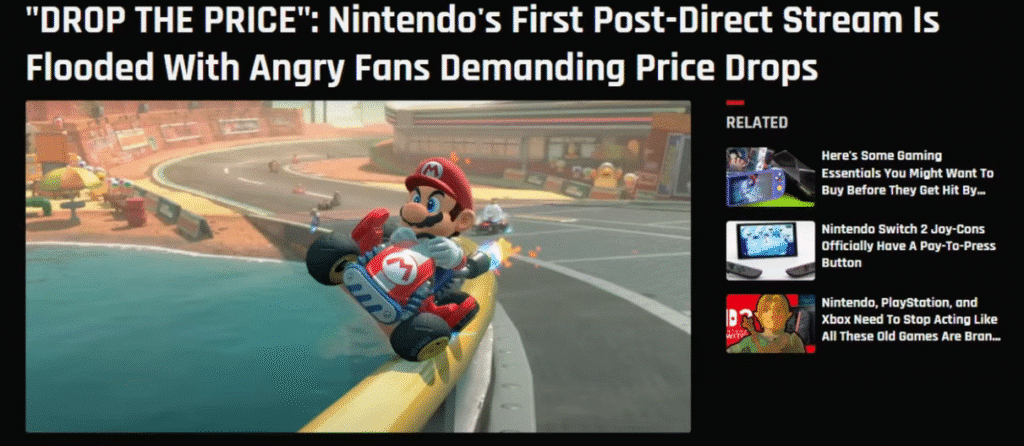Tariffs and Brand Reputation Risk: From Economic Burden to Crisis Trigger
The strategic communication playbook to manage tariffs and brand reputation risk. Learn how to deal with price hikes, 'reshoring washing,' and protect customer loyalty.
October 15, 2025

Tariffs and brand reputation risk are now a real challenge for national and global brands.
Just ask Nintendo. In April 2025, the gaming giant unveiled its anticipated Switch 2 console, but delayed U.S. pre-orders to assess tariffs and market conditions.
By August, Nintendo announced price increases on its original Switch models and select accessories, citing vague “market conditions,” likely referencing the recent tariffs put in place by the Trump administration.
The result?
Social media lit up with frustrated consumers blaming Nintendo for higher prices, not understanding (or caring about) the complex trade policy behind them.

Today, this is a real problem for business executives.
According to KPMG’s latest US CEO Outlook survey, which polled 400 CEOs at companies with at least $500 million in annual revenue, 84% remain upbeat on their company’s growth prospects.
But 89% said tariffs will significantly impact their business performance and operations over the next three years.
The response is predictable: 86% said their organization will raise prices for their goods and services as needed. And 85% of CEOs said they’re already adjusting sourcing strategies to blunt the impact, mainly by shifting more production and materials to the US.
The reality of tariffs and brand reputation risk creates the need to make business decisions that will preserve customer trust and brand perception.
The pricing peril: When explanations for price hikes fall on deaf ears
Here’s the uncomfortable truth: when customers see higher prices, they don’t see government policy. They see corporate greed.
Even when companies like Nintendo explain that “market conditions” drove their decisions, consumers often see price increases as opportunistic profit grabs. This can damage a brand’s image based on perceived unfairness and lack of empathy.
KPMG US chair and CEO Tim Walsh noted that companies are “taking pricing decisions depending on what their consumers can absorb”.
That’s sound business strategy, but it reveals the bigger problem.
Consumers are exhausted from years of post-pandemic inflation, supply chain chaos, and relentless price increases. When brands add “tariffs” to the list of reasons for higher costs, many customers tune out. They’ve heard it all before, and their patience is running out.
A vicious cycle begins. Price-sensitive consumers leave their brands for competitors or cheaper alternatives. So much for the loyalty built over years. Suddenly, the brand isn’t “worth it” anymore.
When almost every company in an industry raises prices simultaneously, what becomes the differentiator?
It’s trust, transparency, and customer experience, not price.

Supply chain shifts: New risks in a fragile system
Supply chain disruption is equally treacherous for brand reputation. These adjustments are affecting retail, technology, automotive, and manufacturing. Moving production away from established facilities in China or other countries creates a perfect storm for a brand reputation crisis.
When companies quickly shift to new countries of origin, consumers, journalists, and activist groups investigate. What are the labor practices? What’s the environmental impact? Are ethical sourcing standards maintained?
A brand will face intense questions about working conditions and sustainability that it may not be prepared to answer convincingly if it moves production from China to Vietnam or another Southeast Asian country.
Then there’s the authenticity problem. Some companies might claim “Made in America” status while only performing final assembly domestically. Call it “reshoring washing.”
Consumers and journalists will fact-check these claims. Any “half-measures” will be punished more severely than honest foreign sourcing. The reputational damage from being exposed as misleading is worse than being transparent about global operations.
Finally, there’s the quality risk during transition. Rushing to change suppliers can lead to inconsistent product quality, inventory shortages, and delivery delays. These issues directly attack the brand’s core promise of reliability.
Once customers experience quality problems, it takes years to rebuild trust.
Tariffs and brand reputation risk: The communication challenge
Most consumers don’t understand tariff policy. They’re often confused with other taxes, trade agreements, or business costs. This creates an enormous educational burden for brands.
Companies must explain complex tariff-related price policy in simple terms without being condescending or evasive.
The risk is real:educational messaging can feel like excuse-making. When a company says “The government has imposed a 25% tax on imported electronics,” some consumers hear “We’re raising prices and blaming someone else.”
Skepticism often greets individual company explanations because they appear self-serving, even when they’re accurate.
A strategic plan to manage reputational risk
How do brands navigate this reputational crisis and protect brand equity? It’s a strategy that requires a multi-pronged approach focusing on transparency, value, and genuine customer partnership.
Be radically transparent about pricing.
Explain price increases as a direct reaction to external government policy. Don’t make it sound like a discretionary business decision. Use plain language, like, “The government has imposed a 25% tax on imported products in our category, adding $X to the cost of each unit.”
Acknowledge the burden higher prices put on customers. Avoid defensive corporate-speak. Show empathy for the financial pressure they’re under.
Reframe supply chain changes around customer benefits.
If you’re shifting production to the US or another location, focus communication on tangible improvements for customers, such as higher quality control, faster delivery, superior customer service, or better responsiveness to issues.
Don’t lead with nationalist messaging or political positioning. Customers care about what’s in it for them, not what’s good for trade policy or your bottom line.
Consider selective absorption.
Not every product needs the same price increase. To protect brand perception, absorb tariff costs on flagship or popular products. Adjust prices on secondary or higher-margin items where customers are less sensitive.
Communicate this choice: “We’re absorbing the cost on this product because it’s important to you.” This demonstrates partnership with customers rather than just passing on every cost.
Double down on customer experience.
When prices rise across an industry, the primary competitive advantage becomes superior customer experience.
In the same KPMG survey, about three-quarters (74%) of CEOs said artificial intelligence is a top investment priority. Those AI investments must translate into better service, faster problem resolution, and genuine added value that offsets negative sentiment from price increases.
The bottom line
The tariff crisis is a test of brand strength, not just financial resilience. Companies that hide behind jargon, use tariffs to cover excessive margin expansion, or make misleading “Made in America” claims will suffer lasting reputational damage.
Brands that emerge with minimal reputational harm will treat customers as intelligent partners deserving honesty, not problems to manage. They’ll prioritize transparent communication over defensive deflection and demonstrate clear, tangible value beyond passing on costs.
Companies can overcome the reputational challenge by maintaining trust when forced into actions that customers perceive as harmful to their interests.
Current boardroom decisions on pricing and supply chains will shape future brand perceptions.
Choose wisely.
Ready to learn more?
Connect with a strategist for a no-obligation session designed to pinpoint your brand's biggest opportunities and get a clear path to successful outcomes.

POST AUTHOR
Core services
Digital marketing
audit services
Discover how to improve marketing campaigns, strengthen the impact of every customer touchpoint, and focus resources on the actions that generate more revenue.
Customer experience strategy consulting
Turn raw customer data into audience personas and laser-focused messaging.
